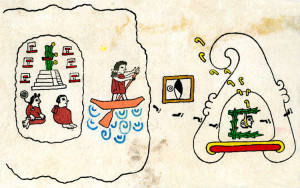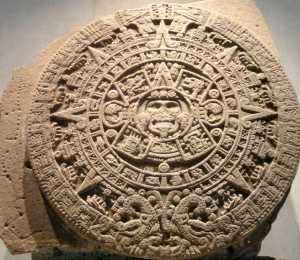Tenochtitlan
Mexcaltitán
 Mexcaltitán is a small inhabited island in North West Mexico that is laid out with concentric streets intersected by two perpendicular avenues(a). Some locals compared its layout to that of old maps of Tenochtitlán the legendary capital of the Aztecs, which in turn has been proposed as having a connection with Atlantis. The idea is totally fanciful and does not stand up to the most cursory examination.
Mexcaltitán is a small inhabited island in North West Mexico that is laid out with concentric streets intersected by two perpendicular avenues(a). Some locals compared its layout to that of old maps of Tenochtitlán the legendary capital of the Aztecs, which in turn has been proposed as having a connection with Atlantis. The idea is totally fanciful and does not stand up to the most cursory examination.
(a) https://www.briannissen.com/ (see under texts)
Aucler, Paul
Paul Aucler (1865-1915) was a French archaeologist who published a reconstruction of ancient Carthage in 1899. The layout he presented has been commented on for its similarity with Plato’s description of the capital city of Atlantis.
Robert Stacy-Judd, a prominent diffusionist, was one such commentator who was not suggesting that Carthage was the location of Atlantis, but when a similar layout was to be found at Tenochtitlan (Mexico City) and elsewhere, it, according to him, seemed to imply a common source of inspiration – Atlantis!
Aztecs
The Aztecs of Mexico are believed by many writers to have originated as refugees from Atlantis. Their own traditions claim that they came from Aztlan, a land to the east. Francisco López de Gómara was the first European to suggest this link with Atlantis in 1551[332]. Ignatius Donnelly wrote at length on the subject and had his views frequently reflected in the work of writers at the beginning of the 20th century. Even today, some still associate Atlantis with the Aztecs(b), while others think that the Olmecs, predecessors of the Aztecs and Maya, were Atlantean refugees(c).
Tenochtitlan was the capital the Aztec Empire and at the time it was captured by the Spanish, it was probably one of the largest cities in the world with an estimated population of 200,000.
It is remarkable that the descendants of Moctezuma, the last Aztec emperor are alive, and well and living in Spain today as the noble house of Grau-Moctezuma de Toleriu(a).
The Aztec drawing on the left is interpreted as representing the migration of the Aztecs from an island in the Atlantic to the mainland of America. The assumption is that the island in question was Atlantis! The case for a clear Aztec-Atlantis connection is far from proven.
The first Latin writer of Aztec history was Ixitilxochill, himself of Aztec lineage, who maintained that the Olmecs had come to Eastern Mexico from the Antilles via Florida.
In 1913, Thomas Crawford Johnston claimed that the Aztecs were Phoenician in origin – The civilisation of the Aztecs, using the name as a generic term, came from the eastern shores of the Mediterranean [1902.248].
A few years later, George H. Cooper, an American, proposed that the Aztec Calendar Stone (see right) “is a miniature, in another and advanced form of art, of Stonehenge [236.30]! Additionally, he claimed [p58]that the Pillars of Herakles mentioned by Plato, are a reference to the monoliths of Stonehenge! Cooper goes further and nominates Salisbury Plain, where Stonehenge is located, as the site of the Garden of Eden [p105]!
(a) The House of Moctezuma | andrewcusack.com
(b) Tenochtitlan: The Atlantis of the Ancient Aztec Empire – Pyramidomania (link broken) *
(c) Ancient Olmecs: Survivors of the city-continent of Atlantis (archive.org)
Tenochtitlan
Tenochtitlán was the capital city of the Aztec empire, occupying what is now the centre of Mexico City, in what we know as the  Valley of Mexico. At the time of the Spanish invasion in 1521, it has been estimated that its population numbered over 200,000, making it one of the largest cities in the world at the time. It was built on an island in the middle of a lake(a), a feature often found in many ancient Aztec towns and cities.
Valley of Mexico. At the time of the Spanish invasion in 1521, it has been estimated that its population numbered over 200,000, making it one of the largest cities in the world at the time. It was built on an island in the middle of a lake(a), a feature often found in many ancient Aztec towns and cities.
The features of Tenochtitlán have been frequently compared with Venice and its canal system, not to mention the concentric waterways of Atlantis described by Plato. Like Atlantis, it too has its central pyramidal temples as well as bridges and other structures.
Tenochtitlan had a huge marketplace described in Merry E. Wiesner-Hanks’ book, An Age of Voyages [1773]. “Tenochtitlan has a great marketplace where ‘sixty thousand people come each day to buy and sell… Its merchandise included ornaments of gold and silver, lead, brass, copper, tin, stones, shells, bones, and feathers …”(d).
The pros and cons of Mexico hosting Atlantis are discussed by Lawrence Freeman, author of Beyond the Pillars: a search for Antediluvian civilizations(f), in a 2000 paper(e).
Edward Ziomek continues to promote the idea of a Mexican Atlantis centred on Tenochtitlán(b) and/or Teotihuacan(c).
(a) https://mitchtestone.blogspot.com/2008/09/island-city-of-tenochtitlan.html
(b) https://www.eupedia.com/forum/archive/index.php/t-9206.html
(c) https://www.flickr.com/photos/10749411@N03/5068038568
(d) Tenochtitlan: The Atlantis of the Ancient Aztec Empire – Pyramidomania (archive.org)
(e) http://web.archive.org/web/20220726040126/https://chapala.com/chapala/Oct2000.html
(f) http://lfreeman.blogspot.com/2006/11/beyond-pillars-search-for-antediluvian.html


